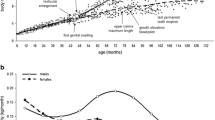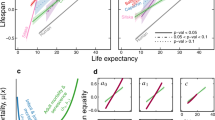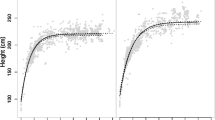Abstract
Primates grow and develop slowly for mammalian standards. Charnov showed that primates grow at only about 40% of the rates observed in other mammals of similar size. However, previous estimates of growth rates in primates were derived from regressions of adult body weight on age at first reproduction in different species, and therefore represent only an average trend for primates. Based on Charnov’s ‘growth law’, we estimated the growth constant A directly from published growth curves for 36 primate species from strepsirrhines to apes. We show that although primate growth is slow in all sampled species in comparison with the mammalian average, there is significant variation around the primate mean. Lemurids are particularly interesting due to their wide range of A values, and further study is required to determine whether environmental unpredictability could lead to the evolution of both very fast and very slow grow in different species. Results also indicate significant negative correlations between the growth constant A and both age at first reproduction and duration of the juvenile period, lending support to the juvenile risk hypothesis.





Similar content being viewed by others
References
Aiello, L. C., & Wheeler, P. (1995). The expensive tissue hypothesis. Current Anthropology, 36, 199–221. doi:10.1086/204350.
Charnov, E. L. (1993). Life history invariants. Some explorations of symmetry in evolutionary ecology. Oxford: Oxford University Press.
Charnov, E. L., & Berrigan, D. (1993). Why do primates have such long lifespans and so few babies? Evolutionary Anthropology, 1, 191–194. doi:10.1002/evan.1360010604.
Clutton-Brock, T. H., & Harvey, P. H. (1980). Primates, brains and ecology. Journal of Zoology, 207, 151–169.
Eveleth, P. B., & Tanner, J. M. (1992). Worldwide variation in human growth. Cambridge: Cambridge University Press.
Foley, R. A., & Lee, P. C. (1991). Ecology and energetics of encephalization in hominid evolution. Philosophical Transactions of the Royal Society of London. B, 334, 223–232. doi:10.1098/rstb.1991.0111.
Harvey, P. H., & Clutton-Brock, T. H. (1985). Life history variation in primates. Evolution; International Journal of Organic Evolution, 39, 559–581. doi:10.2307/2408653.
Hill, K., & Hurtado, A. M. (1996). Ache life history: The ecology and demography of a foraging people. New York: Walter de Gruyter.
Janson, C. H., & van Schaik, C. P. (1993). Ecological risk aversion in juvenile primates: Slow and steady wins the race. In M. D. Pereira & L. A. Fairbanks (Eds.), Juvenile primates: Life history, development and behaviour (pp. 57–74). Oxford: Oxford University Press.
Johnson, S. E. (2003). Life history and the competitive environment: Trajectories of growth, maturation, and reproductive output among Chacma Baboons. American Journal of Physical Anthropology, 120, 83–98. doi:10.1002/ajpa.10139.
Kaplan, H. S., Hill, K., Lancaster, J. B., & Hurtado, A. M. (2000). A theory of human life history evolution: Diet, intelligence, and longevity. Evolutionary Anthropology, 9, 156–185. doi:10.1002/1520-6505(2000)9:4<156::AID-EVAN5>3.0.CO;2-7.
Kappeler, P. M. (1996). Causes and consequences of life history variation among strepsirrhine primates. American Naturalist, 148, 868–887. doi:10.1086/285960.
Kappeler, P. M., & Pereira, M. E. (Eds.). (2003). Primate life history and socioecology. Chicago: University of Chicago Press.
Lande, R. (1985). Genetic and evolutionary aspects of allometry. In W. L. Jungers (Ed.), Size and scaling in primate biology (pp. 21–32). New York and London: Plenum Press.
Leigh, S. R. (1994a). Ontogenetic correlates of diet in anthropoid primates. American Journal of Physical Anthropology, 94, 499–522. doi:10.1002/ajpa.1330940406.
Leigh, S. R. (1994b). The relations between captive and wild-shot weights in anthropoid primates. Zoo Biology, 13, 21–44. doi:10.1002/zoo.1430130105.
Leigh, S. R. (1996). Evolution of human growth spurts. American Journal of Physical Anthropology, 101, 455–474. doi:10.1002/(SICI)1096-8644(199612)101:4<455::AID-AJPA2>3.0.CO;2-V.
Leigh, S. R. (2001). The evolution of human growth. Evolutionary Anthropology, 10, 223–236. doi:10.1002/evan.20002.
Leigh, S. R., & Shea, B. T. (1996). Ontogeny of body size variation in African apes. American Journal of Physical Anthropology, 99, 43–65. doi:10.1002/(SICI)1096-8644(199601)99:1<43::AID-AJPA3>3.0.CO;2-0.
Leigh, S. R., & Terranova, C. J. (1998). Comparative perspecties of bimaturism, ontogeny, and dimorphism in lemurid primates. International Journal of Primatology, 19, 723–749. doi:10.1023/A:1020381026848.
Marino, L. (1998). A comparison of encephalisation between odontocete cetaceans and anthropoid primates. Brain, Behavior and Evolution, 51, 230–238. doi:10.1159/000006540.
Martin, R. D., Genoud, M., & Hemelreik, C. K. (2005). Problems of allometric scaling analysis: Examples from mammalian reproductive biology. The Journal of Experimental Biology, 2008, 1731–1747. doi:10.1242/jeb.01566.
Pochron, S. T., Tucker, W. T., & Wright, P. C. (2004). Demography, life history and social structure in Propithecus diadema edwardsi from 1986–2000 in Ranomafana National Park, Madagascar. American Journal of Physical Anthropology, 125, 61–72. doi:10.1002/ajpa.10266.
Purvis, A. (1995). A composite estimate of primate phylogeny. Philosophical Transactions of the Royal Society of London. Series B, 348, 405–421. doi:10.1098/rstb.1995.0078.
Purvis, A., Webster, A. J., & Agapow, P. M. (2003). Primate life histories and socioecology. In P. M. Kappeler & M. E. Pereira (Eds.), Primate life histories and phylogeny (p. 23). Chicago: University of Chicago Press.
Ravosa, M. J., Meyers, D. M., & Glander, K. E. (1993). Relative growth of the limbs and trunk in sifakas: Heterochronic, ecological and functional considerations. American Journal of Physical Anthropology, 92, 499–520. doi:10.1002/ajpa.1330920408.
Richard, A. F., Dewar, R. E., Schwartz, M., & Ratsirarson, J. (2002). Life in the slow lane? Demography and life history of male and female sifaka (Propithecus verreauxi verreauxi). Journal of Zoology (London, England), 256, 421–436.
Ross, C. (1998). Primate Life Histories. Evolutionary Anthropology, 6, 54–63. doi:10.1002/(SICI)1520-6505(1998)6:2<54::AID-EVAN3>3.0.CO;2-W.
Ross, C. (2004). The evolution of thought. In A. E. Russon & D. R. Begun (Eds.), Life histories and the evolution of large brain size in great apes (pp. 122–139). Cambridge: Cambridge University Press.
Stearns, S. C. (1983). The influence of size and phylogeny on patterns of covariation among life-history traits in the mammals. Oikos, 41, 173–187. doi:10.2307/3544261.
Stearns, S. C. (1992). The evolution of life histories. Oxford: Oxford University Press.
Walker, R., Hill, K., Burger, O., & Hurtado, A. M. (2006). Life in the slow lane revisited: Ontogenetic separation between chimpanzees and humans. American Journal of Physical Anthropology, 129, 577–583. doi:10.1002/ajpa.20306.
West, G. B., Brown, J. H., & Enquist, B. J. (2001). A general model for ontogenetic growth. Nature, 413, 628–631. doi:10.1038/35098076.
Wright, P. C. (1999). Lemur traits and Madagascar ecology: Coping with an island environment. Yearbook of Physical Anthropology, 110, 31–72. doi:10.1002/(SICI)1096-8644(1999)110:29+<31::AID-AJPA3>3.0.CO;2-0.
Author information
Authors and Affiliations
Corresponding author
Electronic supplementary material
Below is the link to the electronic supplementary material.
Rights and permissions
About this article
Cite this article
Mumby, H., Vinicius, L. Primate Growth in the Slow Lane: A Study of Inter-Species Variation in the Growth Constant A . Evol Biol 35, 287–295 (2008). https://doi.org/10.1007/s11692-008-9040-9
Received:
Accepted:
Published:
Issue Date:
DOI: https://doi.org/10.1007/s11692-008-9040-9




